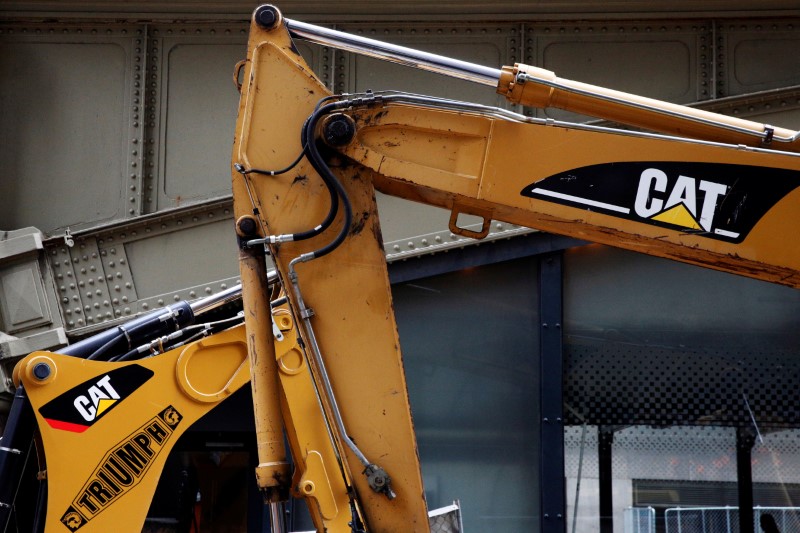By Lucia Mutikani
WASHINGTON (Reuters) - New orders for U.S.-made capital goods and shipments unexpectedly fell in May, but upward revisions to data for the prior month pointed to moderate growth in business spending on equipment in the second quarter.
Other reports on Wednesday showed a sharp narrowing in the goods trade deficit last month, the latest indication that the economy was accelerating this quarter after losing some steam at the start of the year.
There are, however, fears that escalating tensions between the United States and its major trade partners, including China, Mexico, Canada and the European Union, could hurt business sentiment, disrupt supply chains and undercut economic growth.
"Factory managers are worried about the prospects of a full-blown trade war," said Ilir Hysa, a senior economist at Moody's Analytics in West Chester, Pennsylvania. "That said, the sentiment reflected in the manufacturing surveys is not rattled. But trade policy tensions are clearly a major hurdle."
The Commerce Department said orders for non-defense capital goods excluding aircraft, a closely watched proxy for business spending plans, slipped 0.2 percent last month. April data was revised to show the so-called core capital goods orders surging 2.3 percent instead of the previously reported 1.0 percent rise.
Economists polled by Reuters had forecast core capital goods orders gaining 0.5 percent last month. Orders increased 6.8 percent on a year-on-year basis.
Shipments of these goods dipped 0.1 percent last month after an upwardly revised 1.0 percent increase in April. Core capital goods shipments are used to calculate equipment spending in the government's gross domestic product measurement.
They were previously reported to have gained 0.9 percent in April. The drop in core capital goods shipments last month did little to dampen expectations of robust GDP growth in the second quarter. Business spending on equipment increased at a 5.5 percent annualized rate in the first quarter and most economists expected a similar pace of growth in the April-June period.
In other data, the Commerce Department said the goods trade deficit declined 3.7 percent to $64.8 billion in May as an increase in exports outpaced a rise in imports. The department also said wholesale inventories increased 0.5 percent in May and stocks at retailers gained 0.4 percent.
The smaller goods trade deficit was seen offsetting an anticipated drag from inventory investment. Reports on the labor market and consumer spending have suggested that economic growth surged in the second quarter. Gross domestic product estimates for the April-June period are as high as a 5.3 percent rate. The economy grew at a 2.2 percent pace in the first quarter.
HOUSING LAGGING
But housing continues to lag the strong economy, with reports on Wednesday showing contracts to buy previously owned homes falling again in May and applications for loans to purchase a home declining sharply last week. The housing market is being hobbled by land and labor shortages, leading to a dearth of houses available for sale.
The dollar firmed against a basket of currencies and prices for U.S. Treasuries rose. Stocks on Wall Street were trading higher.
The slowdown in business spending on equipment is despite the Trump administration's $1.5 trillion income tax cut package, which came into effect in January. Some economists blamed the strengthening U.S. dollar and warned that the government's protectionist trade policy could restrain business investment.
President Donald Trump has imposed tariffs on steel and aluminum imports to protect domestic industries from what he says is unfair foreign competition. Trump has also said he would press ahead with hefty tariffs on $50 billion of Chinese imports and threatened to impose a 20 percent duty on all imports of European Union-assembled cars.
China, Mexico, Canada and the European Union have retaliated in kind. Harley-Davidson Inc (N:HOG) said on Monday it would move production of motorcycles exported to the European Union from the United States to its international facilities and forecast the trading bloc's retaliatory tariffs would cost the company $90 million to $100 million a year.
"Increasing trade protectionism could raise uncertainty and lower confidence, undermining the otherwise positive conditions," said Greg Daco, chief U.S. economist at Oxford Economics in New York.
The decline in orders last month was almost broad. Orders for electrical equipment, appliances and components tumbled 1.5 percent, the biggest drop in six months. Orders for computers and electronic products fell 0.1 percent while those for fabricated metals decreased 1.2 percent.
There were also declines in orders for primary metals. But orders for machinery rose 0.3 percent, extending April's 1.7 percent increase. Overall orders for durable goods, items ranging from toasters to aircraft that are meant to last three years or more, dropped 0.6 percent in May as demand for transportation equipment fell 1.0 percent. That followed a 1.0 percent decrease in durable goods orders in April.

Orders for motor vehicles and parts plunged 4.2 percent last month, the largest decline since January 2015.